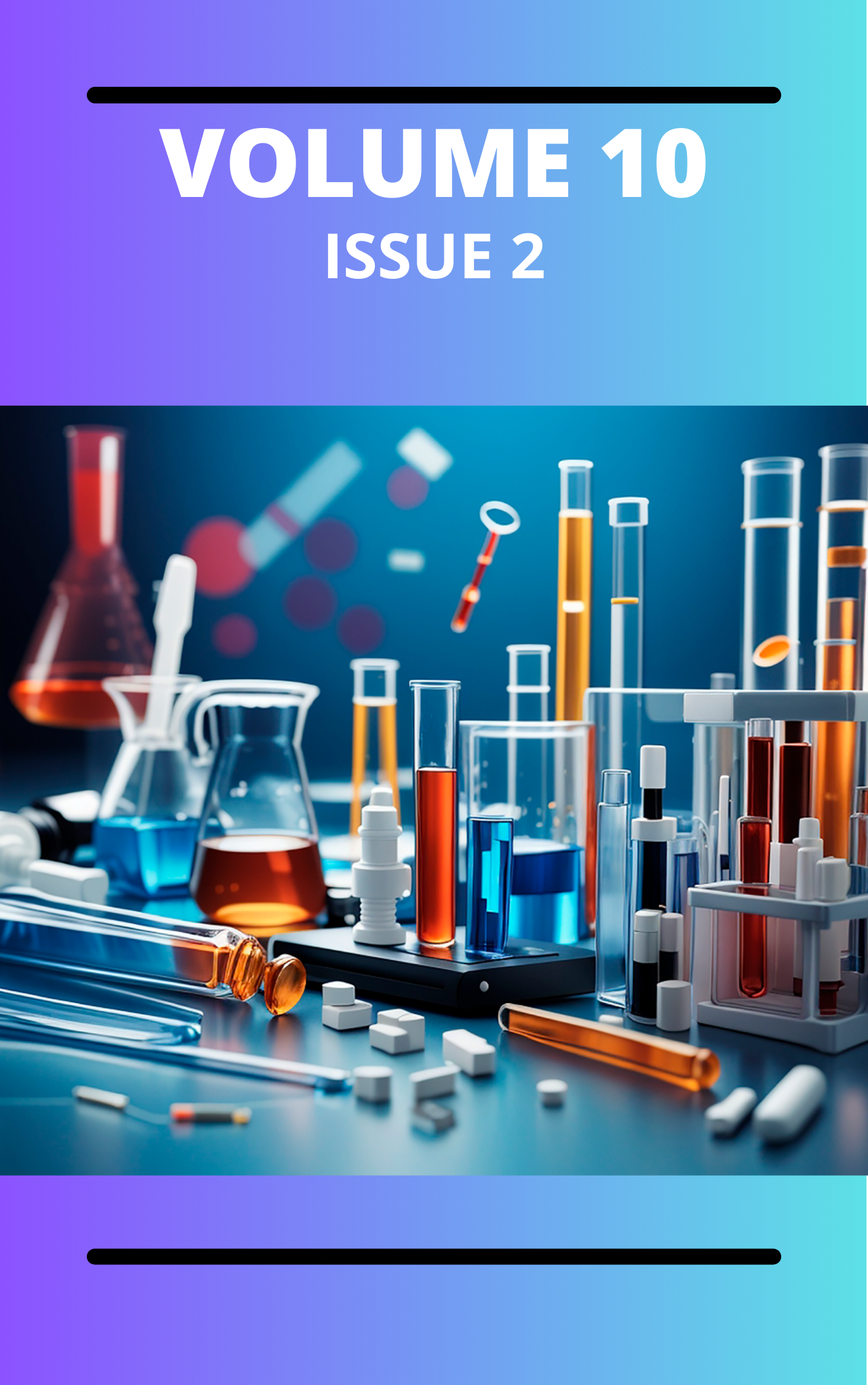Spectrophotometric Investigation of the Redox Reaction of Acid Green 1 with Periodate Ion in Aqueous Acid: Kinetics and Mechanistic Approach
Keywords:
Complex, Kinetics, Reaction, RedoxAbstract
The redox reaction of acid green 1 (AG3-) by periodate ion has been studied in aqueous acid at an ionic strength of I = 0.50 mol dm-3 (NaCl), [H+] = 1.0 × 10-4 mol dm-3, T = 25 ± 1oC and λ = 700 nm. The redox reaction displayed a stoichiometry of 2:1. The reaction showed a first-order dependence on [IO4-] and [AG3-]. Investigation of the effect of ionic strength on the rate of the reaction showed that the rate of the reaction obeyed the positive Bronsted - Debye salt effect. This signified that the activated complex is composed of reactants of like charges. The rate of the reaction increases with an increase in hydrogen ion concentration in the range (0.1 – 4.0) × 10-4mol dm-3 investigated. The addition of acrylonitrile to a partially reacted mixture in the presence of excess methanol did not lead to gel formation. This shows that the participation of free radicals in this reaction is unlikely. Based on the results obtained, the reaction probably obeyed the outer-sphere reaction mechanism.
Downloads
Published
Issue
Section
Similar Articles
- A. D. Onu, Kinetics of Cu2+ - Catalysed Redox Reaction of n-(2-hydroxylethyl) ethylenediaminetriacetatocobalt(III) with Hydrazine Monohydrate in Aqueous Acid , Communication In Physical Sciences: Vol. 3 No. 1 (2018): VOLUME 3 ISSUE 1
- Atim Sunday Johnson, Idongesit Bassey Anweting, Idongesit Edem Okon, Electron Transfer Reactions of Tetrakis (2, 2- Bipyridine)-µ Oxodiiron(III) Complex and Dithionate Ion in Aqueous Acidic Media: Kinetic and Mechanistic Approach , Communication In Physical Sciences: Vol. 10 No. 1 (2023): VOLUME 10 ISSUE 1
- Pius Onyeoziri Ukoha, Uchechukwu Ruth Obeta , Reduction of the Adipato-Bridged Binuclear Iron(III) Complex, [(Fesalen)2adi] by Thioglycolic Acid: Kinetic and Mechanistic Study , Communication In Physical Sciences: Vol. 3 No. 1 (2018): VOLUME 3 ISSUE 1
- B. Myek, S. O. Idris, A. D. Onu, M. K. Yakubu, Kinetics and Mechanism of the Oxidation of Orange II by Chlorate Ion in Aqueous Hydrochloric Acid , Communication In Physical Sciences: Vol. 5 No. 2 (2020): VOLUME 5 ISSUE 2
- Patricia Ese Umoru, Ameh David Onu, The Redox Reaction between Di-μ-Oxo-Tetrakis (2, 2’- bipyridine) – Dimanganese (III, IV) Perchlorate and 1, 3-Dihydroxybenzene in Hydrochloric Acid , Communication In Physical Sciences: Vol. 6 No. 1 (2020): VOLUME 6 ISSUE 1
- Izuagbe Gilbert Osigbemhe , Muluh Emmanuel Khan, SYNTHESIS, SPECTROSCOPIC CHARACTERIZATION AND BIO-INVESTIGATION of N-(2-furylmethylidene)-1,3, 4-thiadiazole-2-amine and its Iron (III) COMPLEXES , Communication In Physical Sciences: Vol. 12 No. 4 (2025): VOLUME1 2 ISSUE 4
- Nsikanabasi Ekerete Nkom, Ededet Akpan Eno, Atim Sunday Johnson, Idongesit Bassey Anweting, SYNTHESIS AND CHARACTERIZATION OF 4- AMINO-3-MERCAPTO-5-METHYL-1, 2, 4 -TRIAZOLE AND ITS MIXED- LIGANDS COMPLEX WITH Cd (II) IONS , Communication In Physical Sciences: Vol. 12 No. 6 (2025): Volume 12 ISSUE 6
- Ifeanyi E. Otuokere, K. K. Igwe, Ni(II) complex of (3,3-dimethyl-7-oxo-6-(2-Phenylacetamido)-4-thia1-Azabicyclo[3.2.0]heptane-2-carboxylic acid : Synthesis, characterization and antibacterial activities , Communication In Physical Sciences: Vol. 5 No. 1 (2020): VOLUME 5 ISSUE 1
- Uchechukwu Susan Oruma, Pius Oziri Ukoha, Lawrence Nnamdi Obasi, Synthesis, Characterization and Biological Studies of Trinuclear Ce(IV) Salen Capped Complex with 5-amino-2,4,6-tris(4-carboxybenzimino)-1,3-pyrimidine , Communication In Physical Sciences: Vol. 5 No. 3 (2020): VOLUME 5 ISSUE 3
- A.D. Onu, Reduction of Trioxobromate(V)Ion By [Cohedtaoh21- in Acid Medium : Kinetics and Mechanism , Communication In Physical Sciences: Vol. 1 No. 1 (2010): VOLUME 1 ISSUE 1
You may also start an advanced similarity search for this article.




